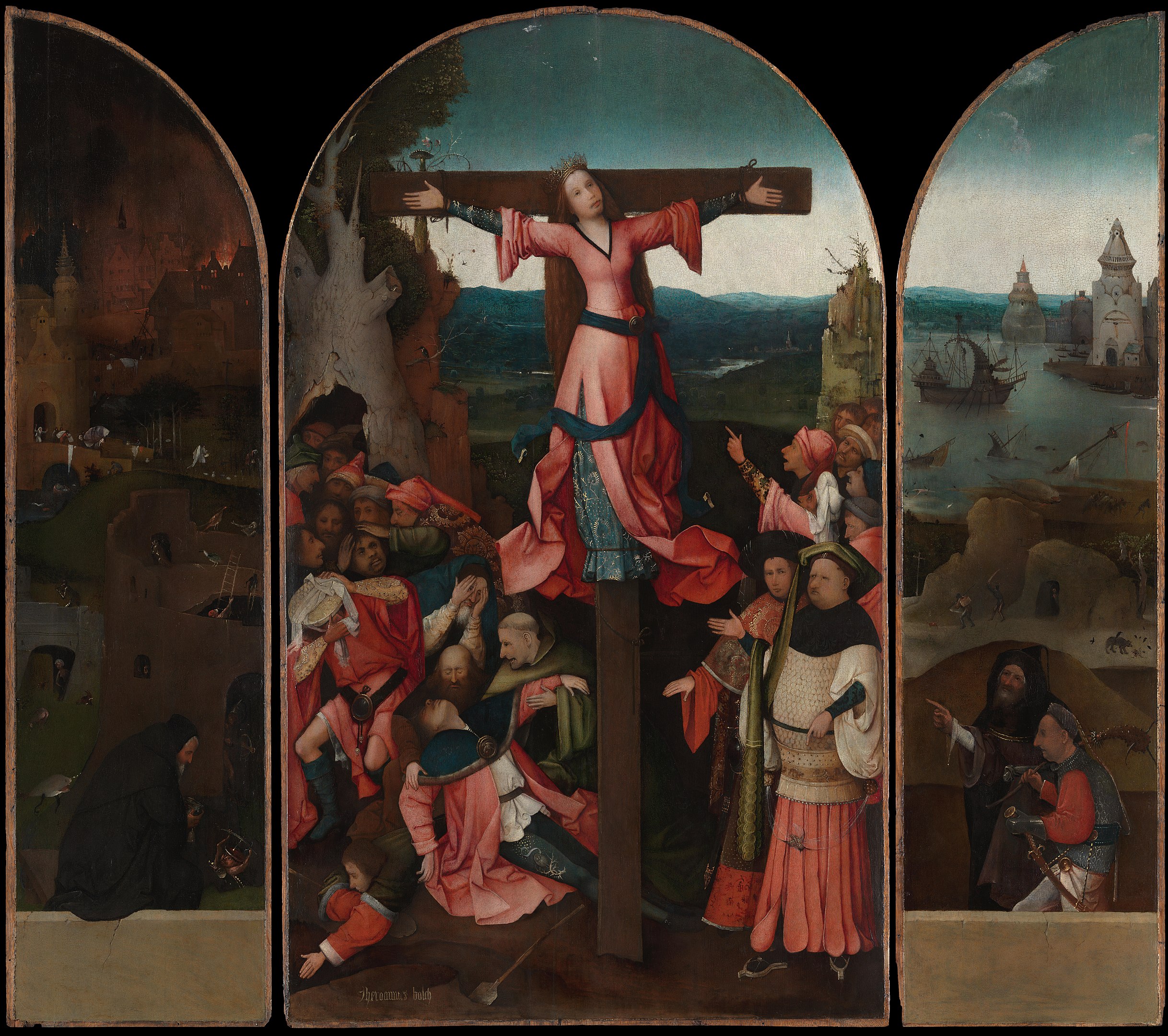Among the forgotten legends of Christendom stands Wilgefortis, the crucified woman with a beard. Her image unsettled the faithful because it broke the logic of gender and form. But behind the strangeness shines a profound sigil. Wilgefortisembodies the paradox where the Christian Cross and the Hermetic caduceus meet. She is woman and man, victim and redeemer, grotesque and luminous. The beard that grew upon her face freed her from a forced marriage, but condemned her to death. Crucified like Christ, she became the representation of a union that cannot be confined to moral order. Her body itself turned into a revelation of the coincidentia oppositorum. To contemplate her is to see Mary and Hermes united. In her flesh the Cross becomes the vessel of Hermes, and Hermes reveals himself as Cross. This is the secret power of her image: the androgynous saint nailed between Heaven and Earth.
I. Vilgeforte and the Paradox of Sanctity
The legend tells that Wilgefortis was the daughter of a pagan king. Promised to a husband she did not choose, she prayed for deliverance. The answer came in the form of a beard. No longer desired as bride, she was denounced and crucified by her father. The bizarre miracle liberated her from the yoke of earthly marriage, but bound her to the eternal Bridegroom. The faithful who venerated her did not see madness. They saw a Holy sign that God’s action breaks the rules of flesh and of society. Her bearded face upon the cross was scandal and consolation. Women trapped in violent unions sought her as patroness, calling her Liberata or Kümmernis. She was the saint of the impossible, the protectress of those without exit. In her the paradox of sanctity becomes visible. Purity is not absence of stain, it is fire that consumes the whole being. By bearing masculine and feminine, she becomes whole. By being unsightly, she becomes radiant. In her crucifixion, the scandal itself is transfigured into Grace.

II. Hermes and the Caduceus of Contraries
The ancient messenger Hermes has always been the lord of crossings. His sign is the caduceus: two serpents intertwined upon a central staff crowned by wings. This rod is revelation. It shows that opposites, when held in balance, do not cancel one another. They rise in spiral around the vertical axis. The caduceus is an image of mediation; union without confusion. Its form is already a living cross, an axis where above and below, left and right, life and death intersect. Hermes teaches that truth is found in the place of tension, in the crossing of paths. He is guardian of roads and patron of travellers. He moves between worlds, divine and mortal. The Christian Cross carries the same secret in another tongue. Its vertical speaks of Heaven and Earth; its horizontal of human to human. At the centre is the wound, where Spirit and matter meet. When Hermes is seen through the Cross, the message becomes clear. The place of redemption is also the place of paradox. In that intersection, contraries kiss. The Cross and the caduceus proclaim the same mystery, one in pagan language, the other in Christian blood.
III. Rose-Crux and the Body of Wilgefortis
The Rose-Crux has long signified the meeting of wound and flower, death and fragrance. The rose is born upon the wood of the cross, perfume springing from blood. Wilgefortis embodies this union in a singular way. Her body is the cross where contraries are fastened. She is woman, but carries the beard of man. She is crucified victim, yet adored as intercessor. She is luminous to the Spirit. Her crucifixion is the caduceus nailed into wood, serpents transfigured into arms, and wings lifted in martyrdom. In her we glimpse Mary and Hermes in one form. Mary, because she is virgin, spouse of the Divine, bearer of paradox. Hermes, because she is messenger of the in-between, guardian of the place where worlds intersect. Wilgefortis becomes the living Rose-Crux. Her cross is not clean geometry but rather body torn and offered. Her rose is the scandal of the facial hair, the eruption of the impossible. The faithful who saw her image knew instinctively: Holiness is not calm order. It is fire, excess, contradiction.
The power of Wilgefortis is to show that sanctity is not the smoothing of edges but the embrace of paradox entire. The Cross speaks in her with Hermetic tongue. In her, the Mercurial deity reveals himself upon the wood of redemption. To gaze upon Wilgefortis is to learn that holiness is fragile harmony consumed by fire, the paradox nailed, radiant through scandal, transfigured in the wholeness of purity.
Fiat Lux.
